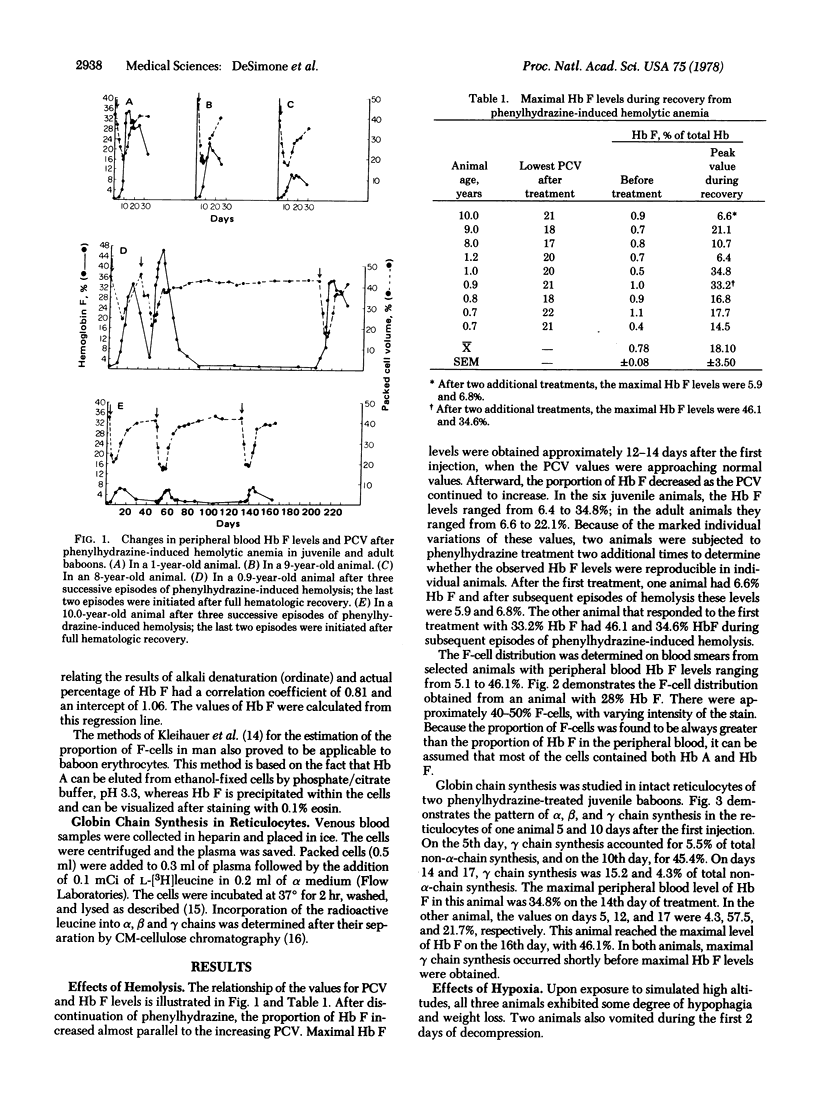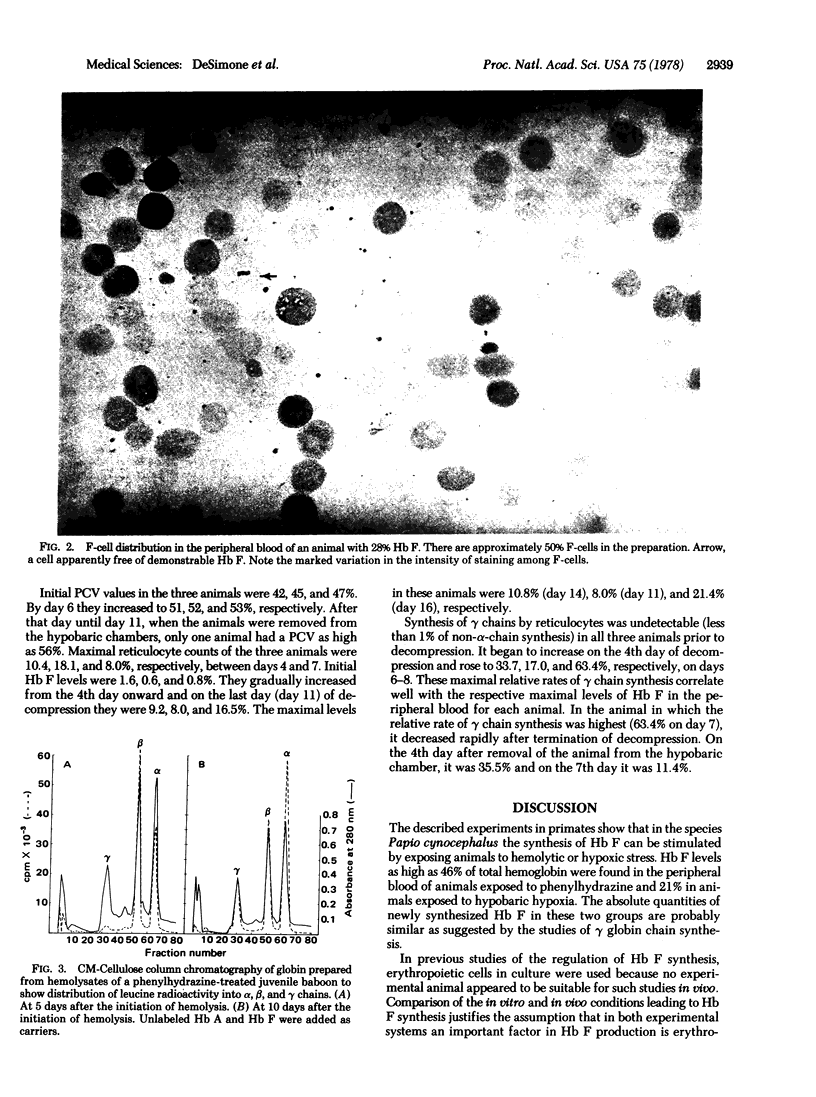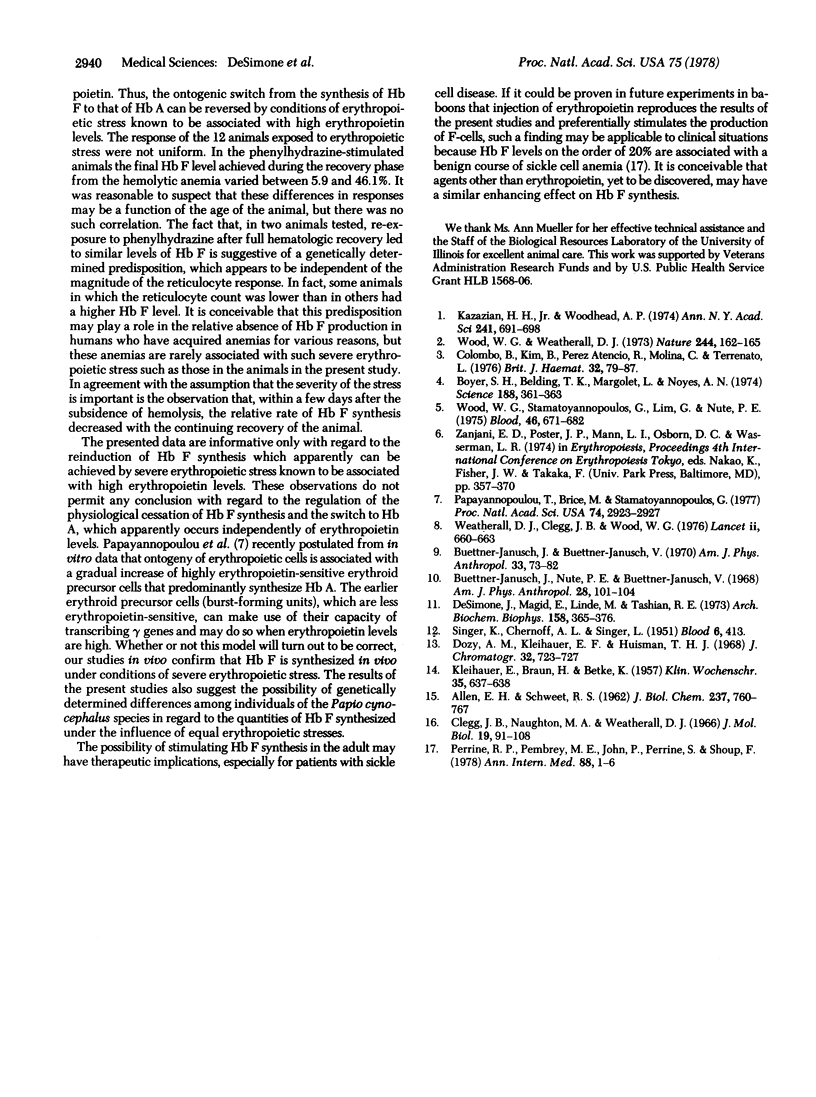Abstract
Fetal hemoglobin (Hb F) levels in the peripheral blood of baboons (Papio cynocephalus) increased from an average value of 0.78% to 18.1% during the recovery phase from phenylhydrazine-induced hemolytic anemia. A similar increase was observed in animals exposed to hypobaric hypoxia. Large individual variations in the maximal Hb F levels were observed which could not be correlated with the ages of the animals. Reinduction of hemolysis in two fully recovered animals resulted in Hb F levels that were of similar magnitude as in the preceding episode, suggesting the possibility of genetically determined individual variations in the rate of Hb F synthesis under the same conditions of erythropoietic stimulation. Reticulocytes from the animals subjected to hemolysis of hypobaric hypoxia synthesized similar absolute quantities of Hb F in vitro. The results of the present studies indicate that the physiological switch from the synthesis of Hb F to that of Hb A during ontogeny can be reversed in adult nonhuman primates by conditions of erythropoietic stress known to be associated with high erythropoietin levels. These findings open the possibility that Hb F synthesis in adult humans may be therapeutically modulated in individuals who might benefit from increased levels of Hb F, such as patients with sickle cell anemia.
Full text
PDF



Images in this article
Selected References
These references are in PubMed. This may not be the complete list of references from this article.
- ALLEN E. H., SCHWEET R. S. Synthesis of hemoglobin in a cell-free system. I. Properties of the complete system. J Biol Chem. 1962 Mar;237:760–767. [PubMed] [Google Scholar]
- Boyer S. H., Belding T. K., Margolet L., Noyes A. N. Fetal hemoglobin restriction to a few erythrocytes (F cells) in normal human adults. Science. 1975 Apr 25;188(4186):361–363. doi: 10.1126/science.804182. [DOI] [PubMed] [Google Scholar]
- Buettner-Janusch J., Nute P. E., Buettner-Janusch V. Fetal hemoglobin in newborn baboons, Papio cynocephalus. Am J Phys Anthropol. 1968 Jan;28(1):101–104. doi: 10.1002/ajpa.1330280120. [DOI] [PubMed] [Google Scholar]
- Clegg J. B., Naughton M. A., Weatherball D. J. Abnormal human haemoglobins. Separation and characterization of the alpha and beta chains by chromatography, and the determination of two new variants, hb Chesapeak and hb J (Bangkok). J Mol Biol. 1966 Aug;19(1):91–108. doi: 10.1016/s0022-2836(66)80052-9. [DOI] [PubMed] [Google Scholar]
- Colombo B., Kim B., Atencio R. P., Molina C., Terrenato L. The pattern of fetal haemoglobin disappearance after birth. Br J Haematol. 1976 Jan;32(1):79–87. doi: 10.1111/j.1365-2141.1976.tb01877.x. [DOI] [PubMed] [Google Scholar]
- Desimone J., Magid E., Linde M., Tashian R. E. Genetic variation in the carbonic anhydrase isozymes of macaque monkeys. 3. Biosynthesis of carbonic anhydrases in bone marrow erythroid cells and peripheral blood reticulocytes of Macaca nemestria. Arch Biochem Biophys. 1973 Sep;158(1):365–376. doi: 10.1016/0003-9861(73)90633-4. [DOI] [PubMed] [Google Scholar]
- Dozy A. M., Kleihauer E. F., Huisman T. H. Studies on the heterogeneity of hemoglobin. 13. Chromatography of various human and animal hemoglobin types on DEAE-Sephadex. J Chromatogr. 1968 Feb 20;32(4):723–727. doi: 10.1016/s0021-9673(01)80551-3. [DOI] [PubMed] [Google Scholar]
- KLEIHAUER E., BRAUN H., BETKE K. Demonstration von fetalem Hämoglobin in den Erythrocyten eines Blutausstrichs. Klin Wochenschr. 1957 Jun 15;35(12):637–638. doi: 10.1007/BF01481043. [DOI] [PubMed] [Google Scholar]
- Kazazian H. H., Jr, Woodhead A. P. Adult hemoglobin synthesis in the human fetus. Ann N Y Acad Sci. 1974 Nov 29;241(0):691–698. doi: 10.1111/j.1749-6632.1974.tb21924.x. [DOI] [PubMed] [Google Scholar]
- Papayannopoulou T., Brice M., Stamatoyannopoulos G. Hemoglobin F synthesis in vitro: evidence for control at the level of primitive erythroid stem cells. Proc Natl Acad Sci U S A. 1977 Jul;74(7):2923–2927. doi: 10.1073/pnas.74.7.2923. [DOI] [PMC free article] [PubMed] [Google Scholar]
- SINGER K., CHERNOFF A. I., SINGER L. Studies on abnormal hemoglobins. I. Their demonstration in sickle cell anemia and other hematologic disorders by means of alkali denaturation. Blood. 1951 May;6(5):413–428. [PubMed] [Google Scholar]
- Weatherall D. J., Clegg J. B., Wood W. G. A model for the persistence or reactivation of fetal haemoglobin production. Lancet. 1976 Sep 25;2(7987):660–663. doi: 10.1016/s0140-6736(76)92469-7. [DOI] [PMC free article] [PubMed] [Google Scholar]
- Wood W. G., Stamatoyannopoulos G., Lim G., Nute P. E. F-cells in the adult: normal values and levels in individuals with hereditary and acquired elevations of Hb F. Blood. 1975 Nov;46(5):671–682. [PubMed] [Google Scholar]



